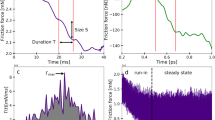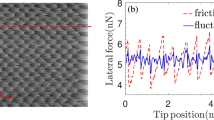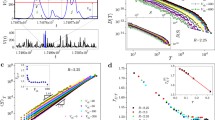Abstract
We investigate statistics and scaling laws of avalanches in two-dimensional frictional particles by numerical simulations. We find that the critical exponent for avalanche size distributions is governed by microscopic friction between the particles in contact, where the exponent is larger and closer to mean-field predictions if the friction coefficient is finite. We reveal that microscopic “slips” between frictional particles induce numerous small avalanches which increase the slope, as well as the power-law exponent, of avalanche size distributions. We also analyze statistics and scaling laws of the avalanche duration and maximum stress drop rates, and examine power spectra of stress drop rates. Our numerical results suggest that the microscopic friction is a key ingredient of mean-field descriptions and plays a crucial role in avalanches observed in real materials.
Graphic abstract








Similar content being viewed by others
Data Availability Statement
This manuscript has associated data in a data repository. [Authors’ comment: All data included in this manuscript are available upon request by contacting with the corresponding author].
Notes
The stress tensor is decomposed as \(\sigma _{\alpha \beta }=-L^{-2}\sum f_{ijn}n_{ij\alpha }r_{ij\beta }-L^{-2}\sum f_{ijt}t_{ij\alpha }r_{ij\beta }\), where \(n_{ij\alpha }\) (\(t_{ij\alpha }\)) is the \(\alpha \)-component of normal (tangential) unit vector. The average of the off-diagonal elements of the first term (on the right-hand-side) is \(\sigma _n\), whereas that of the second term is \(\sigma _t\).
References
J. Lemaitre, J.L. Chaboche, Mechanics of Solid Materials (Cambridge University Press, Cambridge, UK, 1990)
D. Richard, M. Ozawa, S. Patinet, E. Stanifer, B. Shang, S.A. Ridout, B. Xu, G. Zhang, P.K. Morse, J.L. Barrat et al., Phys. Rev. Materials 4, 113609 (2020)
M. Ozawa, L. Berthier, G. Biroli, G. Tarjus, Phys. Rev. Research 2, 023203 (2020)
M. Singh, M. Ozawa, L. Berthier, Phys. Rev. Materials 4, 025603 (2020)
M. Ozawa, L. Berthier, G. Biroli, A. Rosso, G. Tarjus, Proc. Natl. Acad. Sci. USA 115, 6656 (2018)
J.T. Uhl, S. Pathak, D. Schorlemmer, X. Liu, R. Swindeman, B.A.W. Brinkman, M. LeBlanc, G. Tsekenis, N. Friedman, R. Behringer et al., Sci. Rep. 5, 16493 (2015)
A. Nicolas, E.E. Ferrero, K. Martens, J.L. Barrat, Rev. Mod. Phys. 90, 045006 (2018)
M. Henkel, H. Hinrichsen, S. Lübeck, Non-Equilibrium Phase Transitions, Volume I: Absorbing Phase Transitions (Springer Science+Business Media B.V., Dordrecht, The Netherlands, 2008)
S.R. Nagel, Rev. Mod. Phys. 64, 321 (1992)
D.S. Fisher, K. Dahmen, S. Ramanathan, Y. Ben-Zion, Phys. Rev. Lett. 78, 4885 (1997)
J.P. Sethna, K.A. Dahmen, C.R. Myers, Nature 410, 242 (2001)
K.A. Dahmen, Y. Ben-Zion, J.T. Uhl, Phys. Rev. Lett. 102, 175501 (2009)
K.A. Dahmen, Y. Ben-Zion, J.T. Uhl, Nat. Phys. 7, 554 (2011)
N. Friedman, A.T. Jennings, G. Tsekenis, J.Y. Kim, M. Tao, J.T. Uhl, J.R. Greer, K.A. Dahmen, Phys. Rev. Lett. 109, 095507 (2012)
D.V. Denisov, K.A. Lörincz, J.T. Uhl, K.A. Dahmen, P. Schall, Nature Commun. 7, 10641 (2015)
D.A. Geller, R.E. Ecke, K.A. Dahmen, S. Backhaus, Phys. Rev. E 92, 060201(R) (2015)
K.A. Murphy, K.A. Dahmen, H.M. Jaeger, Phys. Rev. X 9, 011014 (2019)
M.A. Sheikh, R.L. Weaver, K.A. Dahmen, Phys. Rev. Lett. 117, 261101 (2016)
J. Antonaglia, W.J. Wright, X. Gu, R.R. Byer, T.C. Hufnagel, M. LeBlanc, J.T. Uhl, K.A. Dahmen, Phys. Rev. Lett. 112, 155501 (2014)
A.A. Long, D.V. Denisov, P. Schall, T.C. Hufnagel, X. Gu, W.J. Wright, K.A. Dahmen, Granular Matter 21, 99 (2019)
D.J. Durian, Phys. Rev. E 55, 1739 (1997)
S. Tewari, D. Schiemann, D.J. Durian, C.M. Knobler, S.A. Langer, A.J. Liu, Phys. Rev. E 60, 4385 (1999)
C. Heussinger, P. Chaudhuri, J.L. Barrat, Soft Matter 6, 3050 (2010)
D. Zhang, K.A. Dahmen, M. Ostoja-Starzewski, Phys. Rev. E 95, 032902 (2017)
K.M. Salerno, C. Maloney, M.O. Robbins, Phys. Rev. Lett. 109, 105703 (2012)
K.M. Salerno, M.O. Robbins, Phys. Rev. E 88, 062206 (2013)
K. Karimi, E.E. Ferrero, J.L. Barrat, Phys. Rev. E 95, 013003 (2017)
M. Talamali, V. Petäjä, D. Vandembroucq, S. Roux, Phys. Rev. E 84, 016115 (2011)
C. Liu, E.E. Ferrero, F. Puosi, J.L. Barrat, K. Martens, Phys. Rev. Lett. 116, 065501 (2016)
J. Lin, E. Lerner, A. Rosso, M. Wyart, Proc. Natl. Acad. Sci. U.S.A. 111, 14382 (2014)
J. Lin, T. Gueudré, A. Rosso, M. Wyart, Phys. Rev. Lett. 115, 168001 (2015)
E.E. Ferrero, E.A. Jagla, Phys. Rev. Lett. 123, 218002 (2019)
E.E. Ferrero, E.A. Jagla, Soft Matter 15, 9041 (2019)
P.D. Ispánovity, L. Laurson, M. Zaiser, I. Groma, S. Zapperi, M.J. Alava, Phys. Rev. Lett. 112, 235501 (2014)
J. Barés, D. Wang, D. Wang, T. Bertrand, C.S. O’Hern, R.P. Behringer, Phys. Rev. E 96, 052902 (2017)
S. Karmakar, E. Lerner, I. Procaccia, Phys. Rev. E 82, 055103(R) (2010)
E. Lerner, N.P. Bailey, J.C. Dyre, Phys. Rev. E 90, 052304 (2014)
H.G.E. Hentschel, S. Karmakar, E. Lerner, I. Procaccia, Phys. Rev. Lett. 104, 025501 (2010)
S. Karmakar, E. Lerner, I. Procaccia, J. Zylberg, Phys. Rev. E 82, 031301 (2010)
S. Luding, J. Phys.: Condens. Matter 17, 2623 (2005)
K. Saitoh, N. Oyama, F. Ogushi, S. Luding, Soft Matter 15, 3487 (2019)
A.W. Lees, S.F. Edwards, J. Phys. C: Solid State Phys. 5, 1921 (1972)
D. Vågberg, P. Olsson, S. Teitel, Phys. Rev. E 95, 052903 (2017)
T. Hatano, C. Narteau, P. Shebalin, Sci. Rep. 5, 12280 (2014)
K. Dahmen, D. Ertaş, Y. Ben-Zion, Phys. Rev. E 58, 1494 (1998)
E. Aharonov, D. Sparks, Phys. Rev. E 60, 6890 (1999)
J.C. Savage, J. Geophys. Res. 77, 3788 (1972)
B. Shang, P. Guan, J.L. Barrat, Proc. Natl. Acad. Sci. U.S.A. 117, 86 (2020)
D. Bi, J. Zhang, B. Chakraborty, R.P. Behringer, Nature 480, 355 (2011)
M. Otsuki, H. Hayakawa, Phys. Rev. E 83, 051301 (2011)
R. Seto, R. Mari, J.F. Morris, M.M. Denn, Phys. Rev. Lett. 111, 218301 (2013)
M. Grob, C. Heussinger, A. Zippelius, Phys. Rev. E 89, 050201(R) (2014)
M. Wyart, M.E. Cates, Phys. Rev. Lett. 112, 098302 (2014)
R. Mari, R. Seto, J.F. Morris, M.M. Denn, Phys. Rev. E 91, 052302 (2013)
M. Grob, A. Zippelius, C. Heussinger, Phys. Rev. E 93, 030901(R) (2016)
S. Saw, M. Grob, A. Zippelius, C. Heussinger, Phys. Rev. E 101, 012602 (2020)
A. Singh, S. Pednekar, J. Chun, M.M. Denn, J.F. Morris, Phys. Rev. Lett. 122, 098004 (2019)
A. Singh, C. Ness, R. Seto, J.J. de Pablo, H.M. Jaeger, Phys. Rev. Lett. 124, 248005 (2020)
M. van Hecke, J. Phys.: Condens. Matter 22, 033101 (2010)
A.J. Liu, S.R. Nagel, Annu. Rev. Condens. Matter Phys. 1, 347 (2010)
P. Olsson, S. Teitel, Phys. Rev. Lett. 99, 178001 (2007)
A. Tanguy, J.P. Wittmer, F. Leonforte, J.L. Barrat, Phys. Rev. B 66, 174205 (2002)
F. Leonforte, A. Tanguy, J.P. Wittmer, J.L. Barrat, Phys. Rev. B 70, 014203 (2004)
F. Leonforte, R. Boissiere, A. Tanguy, J.P. Wittmer, J.L. Barrat, Phys. Rev. B 72, 224206 (2005)
F. Leonforte, A. Tanguy, J.P. Wittmer, J.L. Barrat, Phys. Rev. Lett. 97, 055501 (2006)
W.G. Ellenbroek, E. Somfai, M. van Hecke, W. van Saarloos, Phys. Rev. Lett. 97, 258001 (2006)
W.G. Ellenbroek, M. van Hecke, W. van Saarloos, Phys. Rev. E 80, 061307 (2009)
R.P. Behringer, D. Bi, B. Chakraborty, S. Henkes, R.R. Hartley, Phys. Rev. Lett. 101, 268301 (2008)
R.A. White, K.A. Dahmen, Phys. Rev. Lett. 91, 085702 (2003)
M. LeBlanc, A. Nawano, W.J. Wright, X. Gu, J.T. Uhl, K.A. Dahmen, Phys. Rev. E 94, 052135 (2016)
B. Andreotti, J.L. Barrat, C. Heussinger, Phys. Rev. Lett. 109, 105901 (2012)
E. Irani, P. Chaudhuri, C. Heussinger, Phys. Rev. Lett. 112, 188303 (2014)
E. Irani, P. Chaudhuri, C. Heussinger, Phys. Rev. E 94, 052608 (2016)
C. Goldenberg, A. Tanguy, J.L. Barrat, Euro. Phys. Lett. 80, 16003 (2007)
B.P. Tighe, E. Woldhuis, J.J.C. Remmers, W. van Saarloos, M. van Hecke, Phys. Rev. Lett. 105, 088303 (2010)
S. Mandal, V. Chikkadi, B. Nienhuis, D. Raabe, P. Schall, F. Varnik, Phys. Rev. E 88, 022129 (2013)
O. Pouliquen, Phys. Rev. Lett. 93, 248001 (2004)
B.A. DiDonna, T.C. Lubensky, Phys. Rev. E 72, 066619 (2005)
C.E. Maloney, Phys. Rev. Lett. 97, 035503 (2006)
C. Heussinger, J.L. Barrat, Phys. Rev. Lett. 102, 218303 (2009)
T. Hatano, J. Phys.: Conf. Series 319, 012011 (2011)
D. Vågberg, P. Olsson, S. Teitel, Phys. Rev. Lett. 113, 148002 (2014)
F. Radjai, S. Roux, Phys. Rev. Lett. 89, 064302 (2002)
G. Combe, V. Richefeu, M. Stasiak, A.P.F. Atman, Phys. Rev. Lett. 115, 238301 (2015)
K. Saitoh, H. Mizuno, Soft Matter 12, 1360 (2016)
K. Saitoh, H. Mizuno, Phys. Rev. E 94, 022908 (2016)
J. Chattoraj, A. Lemaître, Phys. Rev. Lett. 111, 066001 (2013)
A. Lemaître, Phys. Rev. Lett. 113, 245702 (2014)
A. Lemaître, Phys. Rev. E 96, 052101 (2017)
K. Karimi, C.E. Maloney, Phys. Rev. E 92, 022208 (2015)
A. Furukawa, K. Kim, S. Saito, H. Tanaka, Phys. Rev. Lett. 102, 016001 (2009)
C.E. Maloney, M.O. Robbins, Phys. Rev. Lett. 102, 225502 (2009)
V. Chikkadi, G. Wegdam, D. Bonn, B. Nienhuis, P. Schall, Phys. Rev. Lett. 107, 198303 (2011)
V. Chikkadi, S. Mandal, B. Nienhuis, D. Raabe, F. Varnik, P. Schall, Euro. Phys. Lett. 100, 56001 (2012)
P. Olsson, Phys. Rev. E 82, 031303 (2010)
A. Nicolas, J. Rottler, J.L. Barrat, Euro. Phys. J. E 37, 50 (2014)
K. Saitoh, H. Mizuno, Phys. Rev. E 96, 012903 (2017)
N. Oyama, H. Mizuno, K. Saitoh, Phys. Rev. Lett. 122, 188004 (2019)
K. Saitoh, R.K. Shrivastava, S. Luding, Phys. Rev. E 99, 012906 (2019)
Acknowledgements
I thank Norihiro Oyama for fruitful discussions and helpful comments on the manuscript. This work was financially supported by JSPS KAKENHI Grant Numbers 18K13464, 20H01868, and 21H01006.
Author information
Authors and Affiliations
Corresponding author
Appendices
Additional data
Double logarithmic plots of a the mean avalanche size \(\langle S\rangle \), b mean avalanche interval \(\langle \varDelta \gamma \rangle \), c mean avalanche duration \(\langle T\rangle \), and d mean maximum stress drop rate \(\langle M\rangle \) as functions of the friction coefficient \(\mu \). The symbols represent the system size N as listed in the legend of (a). The horizontal dashed lines indicate the values in the frictionless system, \(\mu =0\), while the shaded regions indicate the frictionless limit, \(\mu <\mu _c\sim 10^{-5}\)
In this appendix, we show additional data of our numerical simulations.
In Fig. 2, the avalanche size distributions P(S), distributions of the avalanche duration P(T), and power spectra of stress drop rates \(F(\omega )\) are arbitrarily shifted downward to prevent overlap. In Fig. 3c and d, the avalanche duration over the square root of avalanche size, \(T/S^{1/2}\), and the maximum stress drop rate over the square root of avalanche size, \(M/S^{1/2}\), are also shifted downward, respectively. Here, we present their raw data. Figure 7a–e display P(S), P(T), \(F(\omega )\), \(T/S^{1/2}\), and \(M/S^{1/2}\), respectively, where the symbols represent the friction coefficient \(\mu \) (as listed in (a)) and no data are shifted downward from the original positions. In addition, Fig. 7f plots the raw data of those in Fig. 6.
Finite size scaling in frictional systems
In this appendix, we explain how the microscopic friction alters the finite size scaling established for the frictionless system and discuss the frictionless limit.
Figure 8 displays (a) the mean avalanche size \(\langle S\rangle \) and (b) mean avalanche interval \(\langle \varDelta \gamma \rangle \) as functions of the friction coefficient \(\mu >0\), where we change the system size N as listed in the legend of (a). As can be seen, the system size dependence of \(\langle S\rangle \) and \(\langle \varDelta \gamma \rangle \) is sensitive to \(\mu \) so that the scaling relations established for the case of \(\mu =0\) (Eqs. (9) and (11)) are not applicable to \(\mu >0\). In this figure, we also show (c) the mean avalanche duration \(\langle T\rangle \) and (d) mean maximum stress drop rate \(\langle M\rangle \) as functions of \(\mu \). All the mean values significantly deviate from the frictionless cases (horizontal dashed lines) if the friction coefficient exceeds the critical value \(\mu _c\sim 10^{-5}\). Here, the critical value can be estimated as follows: In each time step, the strain increment \(\delta \gamma \) is applied to the system, where the tangential displacement between the particles in contact is roughly estimated as \(\mathrm{d}_0\delta \gamma \) with the mean particle diameter \(\mathrm{d}_0\). The particles “slip” if the static friction \(f_s\sim k_t \mathrm{d}_0\delta \gamma \) exceeds the threshold \(\mu f_n\sim \mu k_n\xi \), i.e. if \(k_t \mathrm{d}_0\delta \gamma >\mu k_n\xi \). Since \(k_n=k_t\) and \(\delta \gamma =10^{-7}\) in our MD simulations, this condition leads to \(\mu <\mu _c\equiv \mathrm{d}_0\delta \gamma /\xi \sim 10^{-5}\), where the overlap between the particles is roughly \(\xi \sim 10^{-2}\mathrm{d}_0\) [99]. Because the critical value \(\mu _c\) is infinitesimal and particles slip every time step, the system is almost frictionless in the limit, \(\mu <\mu _c\) (shaded regions).
Rights and permissions
About this article
Cite this article
Saitoh, K. The role of friction in statistics and scaling laws of avalanches. Eur. Phys. J. E 44, 85 (2021). https://doi.org/10.1140/epje/s10189-021-00089-8
Received:
Accepted:
Published:
DOI: https://doi.org/10.1140/epje/s10189-021-00089-8





